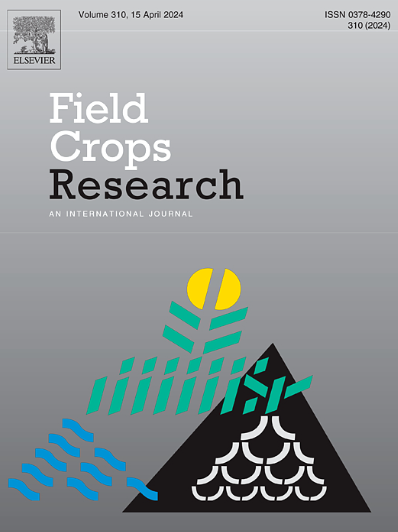Deficit drip irrigation combined with nitrogen application improves cotton yield and nitrogen use efficiency by promoting plant 15N uptake and remobilization
IF 5.6
1区 农林科学
Q1 AGRONOMY
引用次数: 0
Abstract
Context
Deficit irrigation has been widely investigated as a valuable crop production strategy to reduce irrigation water use in arid regions. The nitrogen (N) remobilization from vegetative organs to reproductive organs is vital for enhancing crop yield and N use efficiency (NUE). However, the effect of deficit irrigation on plant N remobilization remain unclear.
Research question
We hypothesized that deficit irrigation combined with reasonable N application can promote cotton N uptake and N remobilization from vegetative organs (stems and leaves) to bolls, thereby increasing cotton yield and NUE.
Methods
A three-year (2020–2022) field-plot experiment was conducted to investigate the impact of different irrigation levels (including full irrigation (FI) and two deficit irrigation treatments (DI1 and DI2, DI1 and DI2 corresponding to 80 and 60 % of FI, respectively) and N application levels (225 (N225), 300 (N300), and 375 (N375) kg ha−1) on the cotton N uptake and yield. In order to further clarify the effects of deficit irrigation on fertilizer N (15N) uptake of cotton and its remobilization from vegetative organs (stems and leaves) to reproductive organs (bolls), a 15N-traced micro-plot experiment was established in 2022 based on the field-plot experiment.
Results
Compared with FI, DI1 significantly increased cotton N uptake and yield, while DI2 treatment significantly reduced cotton N uptake and yield. The cotton yield of DI1 treatment was 8.78 %, 9.76 %, and 7.67 % higher than that of FI treatment in 2020, 2021, and 2022, respectively. The three-year experiment (2020–2022) showed that the DI1 +N300 treatment had the highest N uptake and yield of cotton. The 15N-traced micro-plot experiment revealed that during the pre-bolling stage, the total 15N uptake of cotton plants increased with increasing irrigation and N application. During the post-bolling stage, DI1 greatly increased the bolls 15N uptake, resulting in the total 15N uptake of cotton plants was 5.57–8.72 % and 24.03–33.06 % higher than that of FI and DI2, respectively. The total 15N uptake of cotton plants peaked at the DI1 +N300 treatment. Moreover, compared with FI, DI1 and DI2 significantly increased the remobilization of 15N from vegetative organs (leaves and stems) to bolls (NRT), especially the remobilization from leaves to bolls (NRL), with NRT increasing by 32.24 % and 18.77 %, and NRL increasing by 53.14 % and 43.48 %, respectively. Under FI and DI1 conditions, NRT reached its maximum at N300. However, under DI2 conditions, NRT increased with increasing N application, although there was no significant difference between N300 and N375. The cotton plant 15N recovery under DI1 was 7.84 and 32.15 % higher than that under FI and DI2, respectively. The highest cotton plant 15N recovery was observed in the DI1 +N300 treatment.
Conclusions
Deficit irrigation combined with the N application of 300 kg ha−1 has an advantage in increasing the 15N uptake of cotton plants and promoting 15N remobilization from stems and leaves to bolls during the post-bolling stage, thereby improving cotton yield and NUE.
Significance
This study can provide important information for achieving the synergistic improvement of cotton yield and resources use efficiency in arid regions.
求助全文
约1分钟内获得全文
求助全文
来源期刊

Field Crops Research
农林科学-农艺学
CiteScore
9.60
自引率
12.10%
发文量
307
审稿时长
46 days
期刊介绍:
Field Crops Research is an international journal publishing scientific articles on:
√ experimental and modelling research at field, farm and landscape levels
on temperate and tropical crops and cropping systems,
with a focus on crop ecology and physiology, agronomy, and plant genetics and breeding.
 求助内容:
求助内容: 应助结果提醒方式:
应助结果提醒方式:


